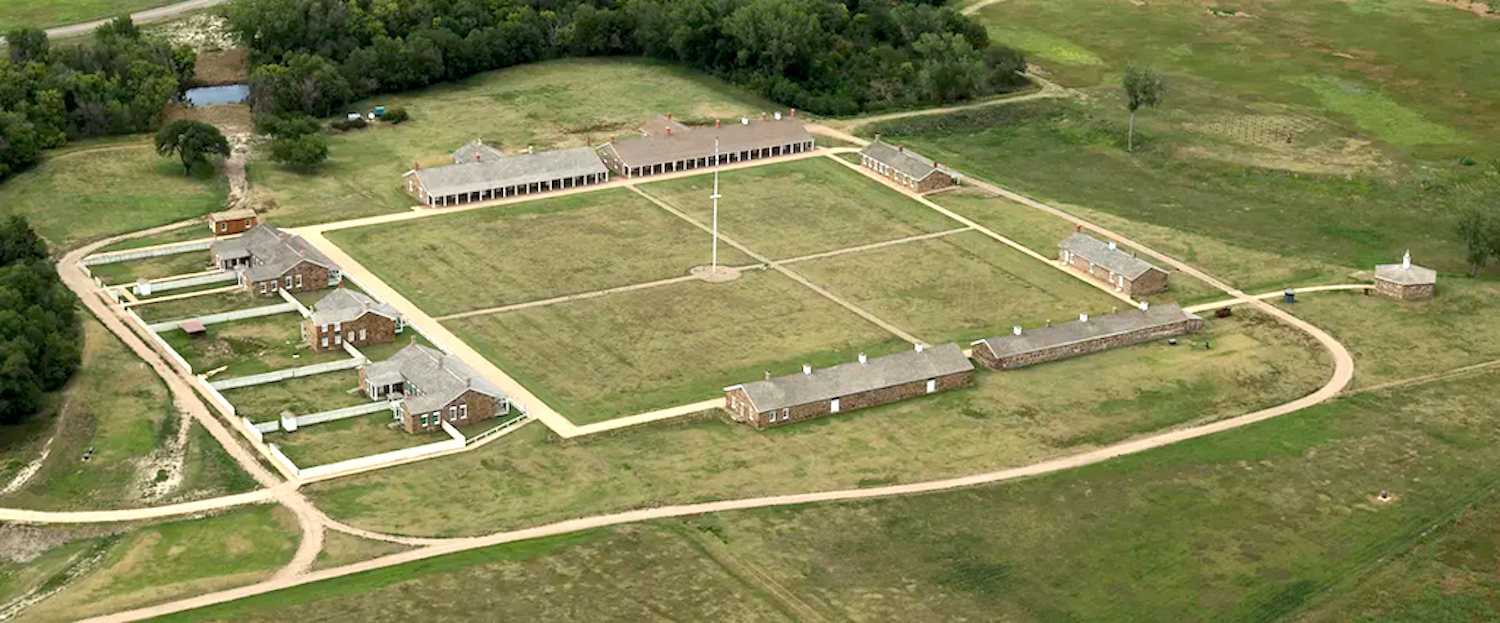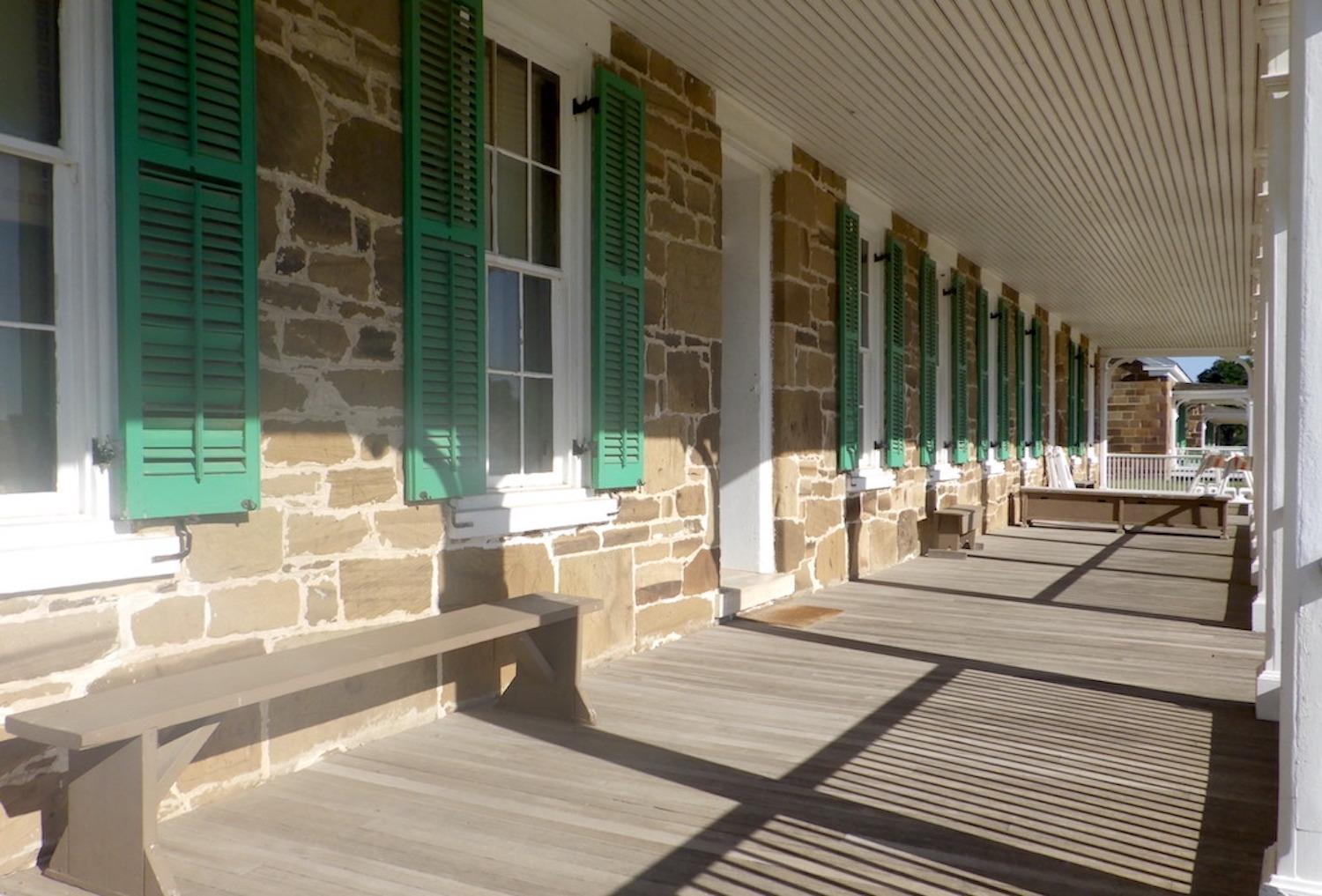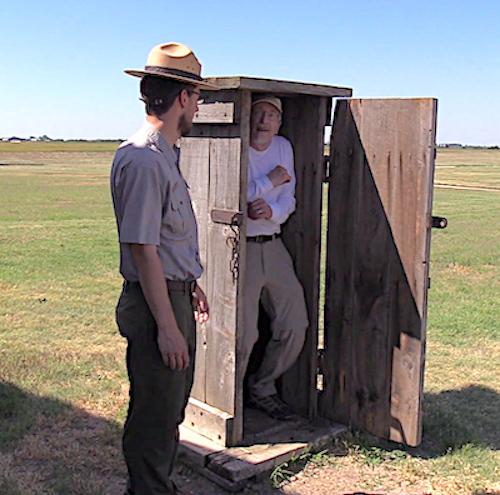
An aerial view of Fort Larned/NPS file
No walls surround Fort Larned on the Kansas prairie, which makes it easy for your eyes to roam across the surrounding countryside that was home to Union soldiers from 1860 to 1878 when they were tasked with guarding travelers along the Santa Fe Trail, protecting mail routes, and negotiating with area tribes that were growing increasingly concerned with the flood of settlers.
Laid out in a large square -- officers' quarters on one side, infantry and cavalry barracks on another, and shop buildings and quartermaster and commissary facilities on two others, all surrounding a large parade ground -- the fort seems to oddly lack walls for protection.
"It's surprisingly common on frontier forts to not have walls. There are a couple of reasons. First of all, there's not a lot of wood out here on the prairie," explained National Park Service Ranger Brian Miller. Plus, the fort's location provided a measure of natural protection, with the Pawnee Fork of the Arkansas River rimming it on two sides and an old oxbow of the river on a third side, he said.
The initial fort site was roughly 2.5 miles downstream along the Pawnee Fork from the eventual, permanent, site, which was selected in 1860. At the time, adobe structures were built for the soldiers, and the commanding officer, Captain Henry W. Wessells, named the fort for Colonel Benjamin Franklin Larned, who was the paymaster for the U.S. Army. Interestingly, Larned never came west to visit the fort.

Fort Larned is the best preserved Civil War-era fort in the National Park System, in part due to the rocks used to build structures like the officers' quarters/Kurt Repanshek
In 1866, using stone they quarried a few miles away, soldiers began to replace the deteriorating adobe structures with stone buildings that remain today. Those stone-built structures help explain why the fort is the best-preserved Civil War-era fort in the National Park System.
"The stonework that we have today comes after the Civil War. Before that it was adobe structures, much like for Fort Union in New Mexico," said Miller. "Of course, adobe doesn't last with time. So just after the Civil War, when there's a height of conflict with the Plains Indians out here, they start building all of these stone structures, and they're all finished by about 1868."
A Window To The Past
Visiting Fort Larned National Historic Site today is akin to stepping into the past and into a fort where the soldiers are away on patrol. Crossing a wooden bridge across languid Pawnee Creek from the parking lot to the fort, you'll find a 99-foot-tall flagpole at the heart of the parade grounds. Whipping in the breeze at the top is a 36-foot by 20-foot U.S. flag with 37 stars reflective of the 37 states that existed in 1868.
The lack of visitors -- only about 80, on average, per day visited Fort Larned last year -- allows for a leisurely visit. Your footsteps landing on the wooden porch planks along the Officers' Quarters and infantry barracks mix with the fluttering flag.
Outside of major holidays such as Memorial Day, the Fourth of July, and Labor Day, you pretty much need to let your imagination add the sounds of drilling troops and cavalry galloping in. Most weekends there's a smithy sweating at the forge in the blacksmith shop, the staccato pounding of his hammer on the anvil reverberating across the fort, and occasionally a baker is at work, though these days they're not cranking out 300 loaves a day as they were in the 1860s to feed the troops.

The commissary carried just about everything the soldiers needed/Kurt Repanshek
It's not hard to envision the physical aspects of the fort as it appeared in the 1860s. The barracks appear as they would with the troops out in the field, beds made and gear stowed. Although, with the soldiers forced to sleep side by side in bunk beds designed for four -- two on the top and two on the bottom -- sleep might have been hard to come by. The hospital, once housing for the 10th Cavalry, features well-spaced beds and yellow-painted flooring intended to make it easier to clean up blood.
Cholera was a common malady, and deadly at times. For relief from boredom, during the warm weather months the soldiers would go swimming in the creek, or they might play billiards in one of the two sutler's stores and bowl at the other.
Next to the blockhouse stands a small, narrow wooden "sweat box" reserved for soldiers who ran afoul of regulations and were locked into this upright box for hours. The commissary, quartermaster's storehouse, and arsenal reflect the supply chain for the Union, and then U.S. Army, soldiers. Casks of salted goods -- pork and bacon -- along with dried hams hanging from the rafters, shelves of canned peaches and other goods, bags of flour, coffee, sugar, and brown sugar and stocks of beans, tobacco, and vinegar are among the items stacked to the rafters in the commissary, while the quartermaster's purview was over clothing, shoes, pails, pots, and even coffins.
The officers' quarters were decidedly more comfortable than those for the infantry and cavalry, particularly if you were a captain. While a lieutenant might have one room that would serve as his bedroom, kitchen, and sitting room, a captain would have had three furnished rooms.
The setting is austere, a snapshot of 19th century military life on the frontier. Missing from it the day I visited was any sign of the Plains tribes that long claimed this challenging landscape, the Kansa, Cheyenne, Osage and Kiowa. The soldiers looked down on these tribes. General Winfield S. Hancock provoked a war with the Cheyenne and Lakota, warning them that, "[Y]ou know very well, if you go to war with the white man you will lose….I have a great many chiefs with me that have commanded more men than you ever saw, and they have fought more great battles than you have fought fights."

The sweat box was a tight squeeze for anyone taller than 5 foot, 7 inches or so/Kurt Repanshek
Hancock's destruction of a Cheyenne village in April 1867 instigated a series of running battles between the tribes and the soldiers, and led in 1868 to the Medicine Lodge Treaty, which was signed at Fort Larned. Along with consigning the Cheyenne to lands south of the fort, the treaty also called for annual disbursements of food, clothing, weapons, and other goods. But it was simply another step towards the end of their way of life on the Plains.
"They have no idea that they are giving up, or that they have ever given up the country which they claim as their own…," wrote Captain Albert Barnitz of the 7th US Cavalry. "The treaty amounts to nothing, and we will certainly have another war sooner or later with the Cheyennes, at least, and probably with the other Indians…"
With the arrival of the transcontinental railroad lessening use of the Santa Fe Trail, the military 1878 abandoned the fort, which went into private hands. In 1885 the fort and much of its land was auctioned to a livestock association, though ownership changed hands several times until 1902, when Edward Everitt Frizell bought the operation and developed it into a successful ranch.
In 1961 the fort was designated a national historic landmark, and in 1964 Congress authorized the National Park Service to add the site to the National Park System.



Comments
I have been to Fort Larned NHS several times over the years on cross-country trips. It is one of my favorite NPS units. The history is interesting and, as Kurt notes, it is easy to envision what it was like for soldiers living at the fort.
The main reason I found the park fascinating is that it is in the middle of "nowhere," and the wide open landscape, endless skies, and peace and quiet are remarkable. Not too far from the main fort is a 44-acre tract of unbroken prairie with intact wagon ruts from the Santa Fe Trail and an active prairie dog town.
So Fort Larned NHS is actually small sampling of the vast shortgrass prairie. And it reminds me of why we need a really large Shortgrass Prairie National Park. We can assemble such a park by incorporating several existing national grasslands that are now poorly protected under U.S. Forest Service administration.
The best frontier cavalry fort in the national park syste.